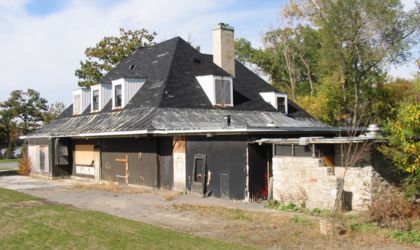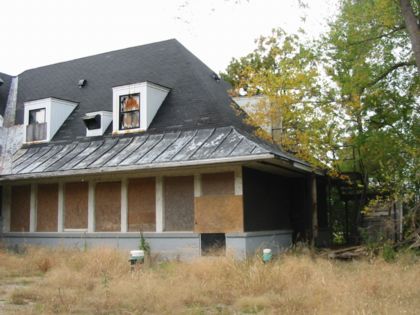Given the NCC Mandate Review Panel's recommendation in 2006 that the NCC be given more responsibility for regional transportation, it's worth remembering what happened the last time the NCC put its oar in - it was a total cock-up.
NCC projects tend to follow a similar trajectory. Out of the blue, they announce a plan. Surprised, then outraged, community groups form to oppose the plan. The NCC announces public consultations. Years of meetings follow wherein the public declares absolute opposition while the NCC doggedly pursues its plan. At the end of the process, the NCC declares the public consulted and proceeds with its original plan. Case in point, the Champlain Bridge expansion.
Hire the consultant
In 1993, the regional government and an interprovincial panel studied the idea of expanding the bridge, but rejected the idea as neither addressing the real problem of interprovincial travel, nor being the appropriate solution. Ottawa community groups thought that was the end of it. But in December 1994, out of the blue, the NCC announced it was spending $450,000 on a study of whether to add a third lane to the bridge. In a curious twist of logic, they claimed they were simply looking at repairing the bridge, but were obliged by the environmental assessment process to examine all options. For the next year, the NCC stuck to its story that it had not decided to add a third lane while consultant McCormick Rankin conducted its study.
Citizen: Champlain Bridge study another NCC gaffe [13 Dec 1994]
In January 1996, the NCC held an open house where the consultant presented various options for a reconfigured bridge, including a high-occupancy-only third lane, while stating once again that it had decided nothing. The proposals also included a host of road works in west Ottawa to accommodate the traffic, including a flyover exit ramp across the Ottawa River Parkway and Island Park Drive; blocking access to Island Park Drive and diverting traffic on to Woodroffe and Parkdale; and building new roads to link the parkway to regional arterials and the Queensway. Regional council, historically a pretty road-friendly bunch, declared opposition to all the options.
In May 1996, the consultant released their cover-all-the-bases recommendation: the Champlain Bridge should remain a two-lane road, but the infrastructure should be built for a future high occupancy vehicle lane.
Ignore the consultant
The NCC board promptly voted in a closed meeting (as usual) to reject the consultant's recommendation and go along with an NCC staff report that proposed three lanes - in short, what they wanted all along - along with modification to roads on the Gatineau side, but none on the Ontario side (not that there was much choice, the region having flatly refused to expand Ottawa roads). NCC staff sold the board on their plan by claiming that adding the third lane while the bridge was being refurbished would cost only $300,000, while adding a third lane later would add $12 million. Board members also cited assurances by NCC staff that the third lane would not lead to increased traffic in Ottawa-Carleton as being another reason for their decision - the flyovers and roadworks in the consultant proposal presumably being just for show. (A 1992 NCC report put the cost of fixing the bridge at $20 million while adding a third lane and improving approach roads would push the price up to about $31 million.)
Soon after, the NCC declared it would not hold public meetings to hear comments on the decision to widen the Champlain Bridge. Anyone wanting to challenge the decision would have to do it in writing. The NCC generously allowed 60 days for submissions when the rules only called for 30.
In July of 96, NCC board member and former Ottawa councillor Joan O'Neill revealed that NCC staff told commissioners during an NCC meeting that the number of vehicles using the link would, in fact, increase to 2,400 in the morning peak hours, up a third from the current 1,600, if a third lane were added to the bridge.
While the three-lane option would increase peak directional service level, the system capacity would not increase and no additional vehicles would, as a result, impact Ottawa-area communities.
NCC Staff Report on the Champlain Bridge
I am having a hard time fathoming that out, saying there won't be more cars on the Ottawa side. I guess all the cars are going to stay on the bridge.
NCC board member Joan O'Neill
Fudge the numbers and hope for the best
Communities Before Cars, a group formed to oppose the NCC's plan, then launched a lawsuit challenging the NCC's decision, prompting the NCC to revisit the proposal. Soon after, the NCC had to admit that their staff originally underestimated the cost of the third-lane option by more than $1 million. NCC staff responded by reducing the width of the bridge to 17.75 from the 18.75 metres recommended in June, reducing the overrun to $400,000. In September, in another closed meeting, the NCC board reaffirmed its decision to widen the bridge.
Citizen: Bad decision made worse [19 Aug 1996]
Citizen: NCC's abysmal political skills cripple sensible bridge plan [5 Sep 1996]
October 1996, another secret meeting, and the NCC board abruptly changes its mind, sort of, by voting to widen the bridge, but operate it as a two-lane link for a year, supposedly so that the municipal governments would be able to decide how to use the bridge. Community groups declared it a victory of sorts, but most understandably believed the rather meaningless compromise to be a ruse by the NCC to buy itself time and defuse opposition.


Chairman Beaudry's apparent conflict
Questions of Chairman Beaudry's conflict of interest in the bridge dispute first cropped up before the board's first vote on the bridge expansion in June 1996. Beaudry owned 1,000 acres of development land in Aylmer, some of it only a few kilometres from the bridge, which he transferred to his wife in 1993. Beaudry withdrew from the NCC's final debates and votes on the bridge (in June, September and October) after being so advised by federal ethics counsellor Howard Wilson. (He did participate in a September debate on whether to open the October meeting to the public.) Mr. Wilson said Mr. Beaudry did not have a real conflict, but should withdraw because some might perceive an "apparent conflict of interest."
In March 1997, in its attempt to get the NCC's bridge decision overturned, Communities Before Cars took the tack that Beaudry's conflict of interest tainted the decision-making process for widening the Champlain Bridge. They pointed out in court that between 1990 and 1992, before Beaudry was appointed, NCC staff opposed widening Champlain Bridge, saying it contravened NCC policy and Federal land-use policy, which considered the bridge part of the "scenic" and "historic" parkway system, and that the bridge should not be considered a major route for commuter traffic.
Citizen: Troubled waters over a bridge [31 Mar 1997]
Citizen: NCC chief's persistent dilemma [31 Mar 1997]
Citizen: NCC powers ahead [11 Aug 1997]
OBJ: Island Paradise? [15 Jul 2009]
Federal Court Justice Francis J. Muldoon at first appeared to agree, telling the court "The fact Mr. Beaudry transferred [the land ownership] to his wife isn't very consoling to a reasonable person. Mr. Beaudry should have placed the land in a blind trust to avoid the appearance of a conflict of interest" and suggesting that it seemed insufficient, at first glance, for Mr. Beaudry to withdraw from the final votes on the bridge reconstruction, after participating in four years of behind-the-scenes planning with NCC staff.
Ultimately, the judge rejected the bid in a decision delivered in August 1997.
Widen the bridge
In November 1997, court battles done, the NCC voted again to proceed with the expansion, despite requests from then Regional Chair-elect Bob Chiarelli to delay. The new middle lane would have reversible flow and be reserved for cars with two or more riders, taxis and buses.
The NCC then spent more than $30 million widening the bridge in a problem-plagued project that took almost four years to complete. The bridge opened July 2002, 20 months behind schedule. Today, traffic is regularly backed up on the NCC's Island Park Drive, and homes sell for hundreds of thousands less.
Unfortunately, the applicants do not have a democratically directly elected level of government whom they could hold responsible electorally for the actions which so displease them. - Justice Francis J. Muldoon